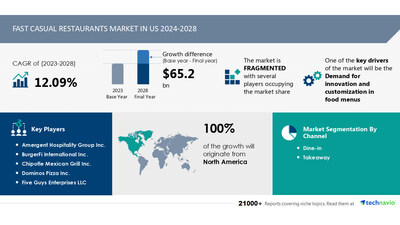Fast Casual Restaurants Market In US size is set to grow by USD 65.2 billion from 2024-2028, demand for innovation and customization in food menus to boost the market growth, Technavio
NEW YORK, Nov. 25, 2024 /PRNewswire/ -- The fast casual restaurants market in USsize is estimated to grow by USD 65.2 billion from 2024-2028, according to Technavio. The market is estimated to grow at a CAGR of 12.09% during the forecast period.
Forecast period | 2024-2028 |
Growth momentum & CAGR | Accelerate at a CAGR of 12.09% |
Market growth 2024-2028 | USD 65.2 billion |
Market structure | Fragmented |
YoY growth 2022-2023 (%) | 11.02 |
Regional analysis | US |
Performing market contribution | North America at 100% |
Key countries | US and North America |
Key companies profiled | Amergent Hospitality Group Inc., BurgerFi International Inc., Chipotle Mexican Grill Inc., Dominos Pizza Inc., Five Guys Enterprises LLC, Godfathers Pizza Inc., Inspire Brands Inc., Focus Brands LLC, MOD Super Fast Pizza LLC, Noodles and Co., Panda Restaurant Group Inc., Panera Bread Co., PORTILLOS Inc., Qdoba Restaurant Corp., Restaurant Brands International Inc., Shake Shack Inc., The Wendys Co., Uncle Maddios Pizza, Wingstop Inc., and YUM Brands Inc. |
Market Driver
The Fast Casual Restaurants market in the US is experiencing significant growth, with trends including high-quality ingredients, locally sourced produce, and fresh food. Millennials are driving demand for organic food, ethnic-inspired dishes, and customization. Fast-casual chains like Panera Bread are leading the way with specialized offerings, quick service, and digital ordering. Technology adoption is key, from online food delivery and door-to-door services to inventory tracking and scheduling software. Operational efficiency and customer satisfaction are top priorities. Product variety is important, with options ranging from burgers and sandwiches to salads, bowls, pizza, and pasta. Fast-casual restaurants are catering to working professionals and health-conscious consumers, offering reasonable prices and healthier options. Entrepreneurs and investors see growth opportunities in franchising and standalone locations. Sustainability practices, such as local sourcing and eco-friendly packaging, are becoming essential. Fast-casual restaurants offer a blend of quick service and high-quality dining experiences, with seating areas, free Wi-Fi, and self-service. Fusion cuisine, plant-based options, and creative personalization are also popular. Food safety concerns and affordability are key considerations. The future of the fast-casual market is about convenience, health consciousness, and culinary traditions.
The US market for fast casual restaurants is witnessing a significant shift towards e-commerce, driven by the expanding tech-savvy population and increased internet access. Consumers now prefer the convenience of online ordering and payment systems, such as credit and debit cards, internet banking, electronic wallets, and cash-on-delivery. E-commerce platforms offer numerous benefits, including ease of use and access to customer reviews, helping consumers make informed decisions. This trend is transforming the way Americans purchase food, making e-commerce a crucial aspect of the fast casual restaurant industry.
Market Challenges
- The Fast Casual Restaurants market in the US is experiencing significant growth, with millennials leading the charge for high-quality, locally sourced produce and fresh food. Fast-casual chains, such as Panera Bread, are offering ethnic-inspired dishes, customization, and quick service, while also focusing on operational efficiency through automation, scheduling software, and inventory tracking. Challenges for this market include the rise of delivery-to-door companies and cloud kitchens, the increasing popularity of plant-based options and healthier choices, and the need for affordability and quality. Fast-casual restaurants are responding by offering specialized menus, quick service, and seating areas with free Wi-Fi. Entrepreneurs and investors see growth opportunities in franchising and standalone restaurants, as well as in digital platforms for online ordering and delivery services. Food choices range from burgers and sandwiches to salads, bowls, pizza, pasta, and wraps, with options for alcoholic beverages and fusion cuisine. Health-conscious consumers are looking for locally sourced, organic, natural, and clean-labeled foods, as well as plant-based menu alternatives and eco-friendly packaging. Food safety concerns and regional tastes are also important considerations. First-mover advantage is crucial in this competitive market, with fast food outlets offering limited menus and faster service. Dine-in and takeaway options are popular, with franchised and standalone restaurants offering a range of seating areas, from self-service to formal dining experiences. Customers value creativity and personalization, as well as sustainability practices and affordable prices. Technology adoption is key to success, with digital inventory tracking, automated purchasing tools, and food delivery systems streamlining operations and increasing customer satisfaction. Pizza preparation and frying processes are being automated, with digital menu boards and payment windows offering convenience. The food service industry is embracing technology to meet the demands of health-conscious consumers and the convenience-driven lifestyle of working professionals.
- Fast-casual restaurants offer a dining experience that falls between quick-service and traditional restaurants. While quick-service restaurants (QSRs) provide the fastest dining experience with options for dining in, drive-thru ordering, and delivery services, fast-casual restaurants are slower than QSRs. Unlike QSRs, fast-casual restaurants offer more menu variety with seasonal updates. The average meal price at fast-casual restaurants is higher than QSRs. QSRs are popular for on-the-go food due to their quick food delivery times. The growth of the QSR industry is primarily driven by an increase in the number of on-premises and drive-through restaurants. Fast-casual restaurants cater to customers seeking a more personalized dining experience with fresher, made-to-order food.
Research report provides comprehensive data on impact of trend, driver and challenges - Request a sample report!
Segment Overview
This fast casual restaurants market in US report extensively covers market segmentation by
- 1.1 Dine-in
- 1.2 Takeaway
- 2.1 North American
- 2.2 Italian
- 2.3 Mexican
- 2.4 Others
- 3.1 Franchised
- 3.2 Standalone
- 4.1 North America
1.1 Dine-in- Fast-casual restaurants, primarily located in the US and Canada, offer a unique dining experience by combining the speed and convenience of fast food with the quality and atmosphere of casual dining. These restaurants typically feature a counter or kiosk ordering system, with customers taking a seat at a table to enjoy their meal. Self-service beverage stations and table service for refills or additional items are common. Many fast-casual restaurants also offer outdoor seating and modern decor for a more inviting dining experience. The growth of fast-casual dining in the US is driven by consumer demand for healthier menu options and a more sustainable approach to food service. The market for fast-casual restaurants is expected to grow due to these advancements and the increasing preference for a balanced dining experience. Fast-casual restaurants provide a comfortable and convenient alternative to traditional fast food, making them a popular choice for consumers.
For more information on market segmentation with geographical analysis including forecast (2024-2028) and historic data (2018 - 2022) - Download a Sample Report
Research Analysis
The Fast Casual Restaurants market in the US is a dynamic segment of the food industry, offering consumers high-quality dining experiences without the formalities of traditional fine dining. These restaurants focus on fresh food, often sourced locally or organically, and feature a limited menu of items such as burgers, sandwiches, salads, bowls, wraps, and alcoholic beverages. The fast-casual concept provides the convenience of quick service, self-service, and seating areas, along with the added benefits of free Wi-Fi and a creative and personalized dining experience. The market caters to various culinary traditions and offers a unique blend of high-quality ingredients and affordable pricing. Fast-casual restaurants have become a popular alternative to both fast-food outlets and fine dining establishments, providing a more personalized and satisfying dining experience.
Market Research Overview
The Fast Casual Restaurants market in the US is experiencing significant growth as consumers seek high-quality, fresh food options that cater to their busy lifestyles and health-conscious choices. This segment of the food service industry offers a variety of cuisines, including burgers, sandwiches, salads, bowls, ethnic-inspired dishes, and more, prepared with locally sourced produce and organic ingredients. Millennials and working professionals are the primary demographic, with a preference for customization, convenience, and quick service. Technology plays a crucial role in the fast-casual sector, with online ordering, delivery services, and door-to-door delivery apps becoming increasingly popular. Automation, scheduling software, and inventory tracking systems help improve operational efficiency and customer satisfaction. Fast-casual chains and standalone restaurants alike offer a range of food choices, from pizzas and pastas to chicken and wraps, with seating areas, free Wi-Fi, and specialized offerings. Entrepreneurs and investors see significant growth opportunities in this sector, with first-mover advantage and licenses available for franchises. The fast-casual market also prioritizes sustainability practices, eco-friendly packaging, and charitable endeavors, making it an attractive option for health-conscious consumers and those seeking a more conscious dining experience. With a focus on affordability and quality, this segment of the food service industry continues to evolve and adapt to consumer preferences and trends.
Table of Contents:
1 Executive Summary
2 Market Landscape
3 Market Sizing
4 Historic Market Size
5 Five Forces Analysis
6 Market Segmentation
- Channel
- Dine-in
- Takeaway
- Product
- North American
- Italian
- Mexican
- Others
- Application
- Franchised
- Standalone
- Nature (Franchised and Standalone)
- Geography
- North America
7 Customer Landscape
8 Geographic Landscape
9 Drivers, Challenges, and Trends
10 Company Landscape
11 Company Analysis
12 Appendix
About Technavio
Technavio is a leading global technology research and advisory company. Their research and analysis focuses on emerging market trends and provides actionable insights to help businesses identify market opportunities and develop effective strategies to optimize their market positions.
With over 500 specialized analysts, Technavio's report library consists of more than 17,000 reports and counting, covering 800 technologies, spanning across 50 countries. Their client base consists of enterprises of all sizes, including more than 100 Fortune 500 companies. This growing client base relies on Technavio's comprehensive coverage, extensive research, and actionable market insights to identify opportunities in existing and potential markets and assess their competitive positions within changing market scenarios.
Contacts
Technavio Research
Jesse Maida
Media & Marketing Executive
US: +1 844 364 1100
UK: +44 203 893 3200
Email: media@technavio.com
Website: www.technavio.com/
![]() View original content to download multimedia:https://www.prnewswire.com/news-releases/fast-casual-restaurants-market-in-us-size-is-set-to-grow-by-usd-65-2-billion-from-2024-2028--demand-for-innovation-and-customization-in-food-menus-to-boost-the-market-growth-technavio-302314956.html
View original content to download multimedia:https://www.prnewswire.com/news-releases/fast-casual-restaurants-market-in-us-size-is-set-to-grow-by-usd-65-2-billion-from-2024-2028--demand-for-innovation-and-customization-in-food-menus-to-boost-the-market-growth-technavio-302314956.html
SOURCE Technavio



